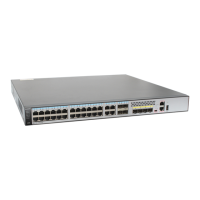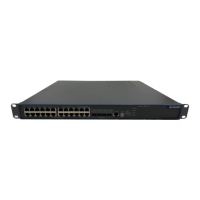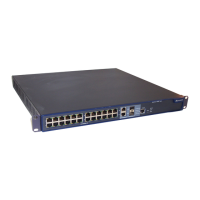The statistics group has one table: ethernetStatsTable.
NOTE
The RMON statistics result is not consistent with the output of the display interface command.
Although data is collected from the bottom layer in both the cases, the RMON information is more
comprehensive.
l History group
A history group periodically collects the network state statistics and stores them for future
reference. The history group has the following tables:
– historyControlTable: is used to set the control information, such as sampling intervals.
– etherHistoryTable: provides network administrators with other history statistics, such
as the traffic on a network segment, error packets, broadcast packets, utilization, and
collisions.
Each entry in the historyControlTable corresponds to a maximum of 10 pieces of history
records in the etherHistoryTable. The previous pieces are overwritten in a circular
manner if the threshold of records in etherHistoryTable is crossed.
l Alarm group
An alarm group allows predefining a set of thresholds for alarm variables (any object in
the local MIB). A monitor records logs or sends trap messages to the NM Station when the
sampled data in a certain direction crosses a threshold.
As defined in RFC 2819, the alarm function has a hysteresis mechanism to limit the
generation of alarms. If this mechanism is adopted, an alarm event is generated when the
sampled data in a direction crosses the threshold. No more events will be generated until
the sampled data in the opposite direction crosses the threshold.
The S5700 does not apply this mechanism because it will not generate the alarms for a long
period. For the S5700, the alarms are re-generated if the smapling value turns to the noraml
threshold.
The alarm group contains one table: alarmTable.
l Event group
An event group stores all the events generated by the RMON agent in a table. It records
logs or sends trap messages to the NM Station when an event occurs.
The event group implements the output of three events: log, trap, and log-trap. Each event
entry corresponds to a maximum of 10 pieces of logs. The previous logs are overwritten in
a circular manner if the threshold of logs is crossed.
The event group has two tables: eventTable and logTable.
l Performance-MIB
The RMON prialarm group is an enhancement of alarmTable defined in RFC 2819.
Compared with the alarmTable, the RMON prialarm group supports the setting of alarm
objects and time spans of alarm entries through expressions.
The RMON Performance-MIB has one table: prialarmTable.
In the S5700, to save system resources, each entry is given a specific time span. The time
span indicates the period for an entry to keep the invalid state. The entry is deleted when
the time span goes down to 0.
Table 7-1 shows the capacity of various tables and the maximum time span of each table.
Quidway S5700 Series Ethernet Switches
Configuration Guide - Network Management 7 RMON Configuration
Issue 01 (2011-10-26) Huawei Proprietary and Confidential
Copyright © Huawei Technologies Co., Ltd.
392

